It is always surprising the range of fruit trees that can be grown if you have no garden to plant in. Your first thought is that 7m cherry tree growing in a large orchard has put you off thinking of growing fruit trees.
Breeders have seen the opportunity and have developed techniques to minimize the height of trees. It is now possible to plant fruit trees in containers, and still get a decent harvest. The technique developed by free tree breeders is called ‘grafting’ in which the fruit producing section, technically called the ‘scion’, is joined to a different variety of fruit tree rootstock.
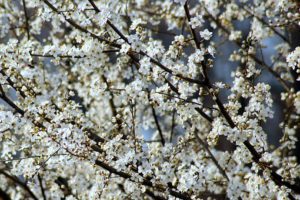
So, for example, a variety of apple trees in the fruiting section will be grafted to another variety of apple in the rootstock. This is done as the rootstock determines the final height the tree will grow to and how vigorously it will grow.
THERE ARE BENEFITS TO GROWING FRUIT TREE IN CONTAINERS
Tall trees are difficult to handle, making fruit picking inconvenient, along with all the pruning that is required to keep it fruiting, making tall fruit trees impossible to have in containers. To combat this, breeders have developed various dwarf rootstocks, and thus reducing the height the tree will obtain.
You may think ‘why don’t I grow my fruit tree from the seeds harvested from the fruit I buy from the supermarkets’. The answer is simple, as the seed you plant will be a cross between the fruit you have eaten and another variety of unknown origin. It takes around 20 years after planting for the tree to produce fruit, and the fruit may not taste like the original, or even worse be totally inedible. The odds are against you if you use this method.
THE ROOTSTOCK IS THE KEY
The rootstock is key to growing in containers, and it’s important before buying any tree to make sure the right rootstock is present.
You need to find out:
- That the rootstock produces dwarf varieties of tree.
- That the tree will do well in the container and the compost within it.
- Not all varieties of fruit trees are suitable to be grown in containers, so look out for’ suitable for containers’ or ‘patio’
- That the tree will do well in your locality.
Generally, cheaper fruit tree stock tends to do well initially as they look healthy, but after a few years, they will struggle. They will simply not produce.

Fruit trees are not for instant gratification as it takes many years before a decent crop is produced. In my experience, it takes at least five years after planting before you get a decent crop, enough to feed everybody on your street. The trouble of most people moving house and leaving the fruit tree behind is avoided, as you can take the tree with you.
PREPARING THE FRUIT TREE FOR PLANTING
Planting trees in containers mostly require similar compost, unless you are planting citrus trees. It is good to use general multipurpose compost, mixed with water retaining crystals, in order to plant the fruit trees in. This is because fruit trees require a lot of water when the fruitlets are forming. This is especially true for fruit trees in the first year, as it takes that long for the tree to establish.
It is a good idea in early spring to add slow release fertilizer, mixed with extra sulphate of potash, bone meal and calcium. This will ensure the tree is healthy and productive.
APPLES
Apple trees are a good subject to container growing, as long as the right rootstock is used. Apple rootstocks are often referred by alphanumerical code, where the letter refers to the trial ground, and the number to the trial number, It must be stressed that there is no correlation between the trial number and the final tree growing size. For example, M27 produces smaller trees than M7.
Apple trees tend to come in eating and cooking varieties (to sour to be eaten directly from the tree), Cooking varieties tend to be large and therefore cannot be grown in containers.
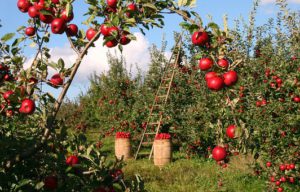
If you want to plant an apple tree, rootstock M26 is recommended, so look for this when purchasing a tree.
The advantage of growing apple trees in a container is that they can be pruned to a number of shapes, from conical to pyramid. One of the easiest apple trees to grow in containers are minarettes, as long as a big enough pot is used. Minarettes have been specially cultivated to produce small fruiting tip spurs directly from the main trunk, rather than producing long branches. They grow to about 2m tall, but not very wide, so making them economical in tight spaces.
As the roots are being constricted by the container, then this ‘stresses’ the tree into producing fruit earlier than those planted directly into the ground. You must allow the apple tree to start getting root bound before moving on to the next available pot size, or fruiting could be delayed.
APPLES CAN BE GROWN MANY DIFFERENT WAYS
The main drawback with apples is that only a small number are self-pollinating. This means that in order to produce fruit another variety is required. Not just any other variety but a variety that flowers at the same time as your apple tree.
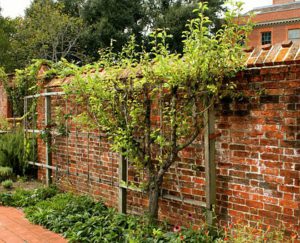
In this regard, crab apple can be used as your ‘all go to’ tree to fertilizer your apple tree. Before buying check your neighbourhood to see if they have any apple trees or crab apple that flowers at the same time as your proposed tree. It may be worthwhile to keep tabs on local trees to see when they flower before buying your preferred tree.
Apples can be grown in a number of different ways from cordons, where the stem is grown at a 45 degree angle, with short fruit spurs, or the aforementioned conical and pyramids. Another possibility is ‘fan’ or ‘espalier’ growing, where the fruit tree is trained to grow against a wall or wired fencing.
CHERRY
Cherry trees come into two different types of sweet dessert cherry and sour cooking varieties. The choice of which to grow is up to you.
The biggest problem when growing cherries is that birds love them as much as you do. A tree can literally be strip to the stone in one night. This is why netting cherry trees is a must.
The tree themselves are very attractive especially in spring, where the flowers will brighten any container garden. Cherry trees by nature tend to be big, making them difficult to plant in containers. Thankfully after many years of research, smaller cherry trees have been developed,
Initially, this was with colt rootstock, but this was still too big for growing dessert cherry trees in.
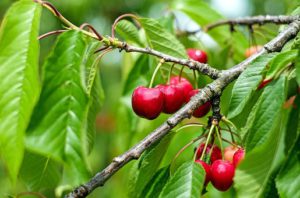
Acidic loving cherries such as Morello grows less vigorously than dessert varieties, and therefore can be grown in containers using Colt as a rootstock. Morello cherries can be grown in the shade and so can be planted north facing.
For dessert cherries, dwarfing rootstock Gisela 5 and Tabel have been developed, so making cherry growing in pots a possibility.
Self –fertile cherry trees use to be a rarity, but Stella revolutionized home growing cherries, and this has led to an array of self-fertile cherry trees. Pruning with cherry trees is best carried out immediately after fruiting, as this will prevent silver leaf forming in the pruned wound. This winter borne disease is fatal to cherry trees.
CITRUS TREE
Lemons, limes, and oranges can be grown in containers. In fact, in cold climates, this is the recommended method as the containers have to be moved in and out of the greenhouse or conservatory, throughout the year.
It is critical that the right growing conditions are met in winter, or the tree will perish. Some varieties can go down to – 5 degrees Celsius but not for long periods of time. It is safe to keep them at 10 degrees Celsius throughout winter, and hence why the pot needs to be moved in. They can be moved outdoors in summer, as long as the night-time temperature does not go below 10 degree Celsius.
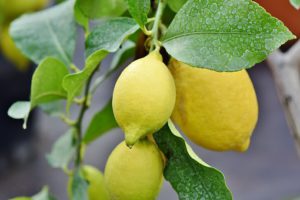
With citrus, you need to use specialized citrus compost, with specialized winter and summer feeds. In summer, the citrus tree fertilizer contains high nitrogen for leaf and shoots growth, whilst the winter feed is more balanced.
Pruning of any citrus tree should be carried out in late winter during the dormant period. All citrus trees are self-fertile. Meaning that you only need one specimen, as they can be quite prolific.
FIGS
Figs can be grown everywhere as they are quite hardy, surviving to -10 degree Celsius. Brown Turkey figs are the most common variety, which tends to be reliable and hardy. The tree is hardy but the growing tips can be damaged by frost. This can be prevented by covering the tip with fleece over the winter months, and this will also safeguard the fruit.
If you treat fig tree too well it will reward you with leaves and no fruit. This is why containers are so beneficial as this will naturally confine the roots of the tree, and stress it. The result would be that it produces fruit more abundantly.
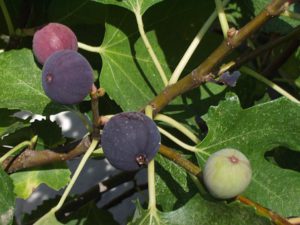
The fig tree does not require much fertilizer, so feed at half the manufacturer’s recommended dosage. If leaves are produced and no fruit, then cut back on the feeding. The tree can be pruned in spring, but not too hard. Be careful when pruning fig trees as they produce a white sap which can be an irritant to the skin, especially when the sun is shining.
In August/September is traditionally when the fruit is ready. You can tell as the fruit changes colour, starts to feel soft and will easily come away from the tree. They will store in a fruit bowl for a few days but can be dried, or made in a jam.
PEARS
Pears, in general, have a similar growing performance to apples but have earlier flowering. This can be problematic in cold area, where a late frost can stop the blooms from producing fruit. To compact this, pears need to be grown in a sheltered position, normally against a wall. This should protect the tree.
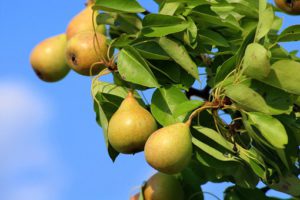
The range of rootstock of pears is limited to quince A and quince C. Quince A is the more common one, whilst Quince C tends to be used for cordon varieties. Concorde is a good variety to grow in exposed sites as it tends to flower much later. Pear also come in self-fertile varieties such as Conference but tend to do better if a pollinating partner that flowers at the same time can be found, within the vicinity of the tree
Pears also come in minarettes, all minarette varieties are suitable to be grown in containers. Pears are a strange fruit as it never ripens on the tree. You need to bring the fruit into the house in order to ripen, but then quickly turns bad if they are not eaten within a day of fully ripening.
NECTARINE AND PEACHES
Once peach and nectarines could only be grown in greenhouses but new development in the ‘Julienne A’ rootstock and other rootstock have allowed these trees to be planted in containers. The only difference between the two is the peaches are hairy, whilst nectarines have a smooth skin.
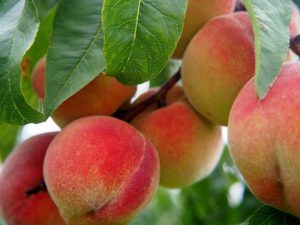
There are a number of varieties that can be grown in containers and this includes ’Bonanza’, ‘Garden Lady’ for peaches, and ‘Nectarella’ and ‘Terrance Ruby’ for nectarines. The advantage for these varieties as they do not require much pruning, and all are slow growing reaching a height of between 1.2m to 1.5m in 10 years.
HOW TO GROW NECTARINES AND PEACHES IN CONTAINERS
In order to succeed the trees need to be planted in a free draining container, as the tree does not like its roots to be soggy. The tree thrives in sun and so plant in a sunny position.
As peach and nectarine trees tend to flower in March, so will need protection from frost. It is recommended that you cover the tree with horticultural fleece if a frost is predicted. Do not forget to take off in the morning as the plant will overheat during the day.
As there are no many pollinating insects in March the chance of the flowers being pollinated can be increased by the use of a painter’s brush. All you need to do is rub inside one flower, pick up the pollen and then transfer it to another flower.
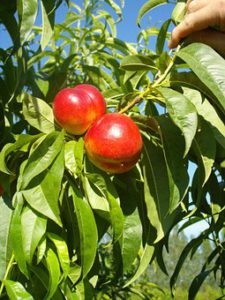
It is advised that once the fruitlets develop to start thinning them out. Start by thinning disease fruit and then thin to one fruit per cluster, ensuring that there is a gap of 5cm between each fruit. Thin again to allow the fruit to swell later on as the fruit develops. If this is done, 20 regular sized fruit will develop through July and September. Pick the fruit once it is fairly ripe. To do this squeeze the fruit gently and if it gives slightly, the fruit is ready. They do not store well and must be eaten in a couple of days.
Patio grown trees do not really suffer as many diseases or pests than those in the ground. The major disease of these trees is peach leaf curl, a fungal disease that weakens the tree. It will eventually kill it.
PLUMS/DAMSONS/GAGES/APRICOTS
Initially, plum trees were very large and very productive. For example, Victorian plum trees can grow to 9m tall, producing over 10kg of fruit. Continual research leads to the discovery of two dwarf rootstocks of St Julienne A and Pixy. These allow the tree to be fan trained or grown in a minarette form.
Plums fruit erratically, either due to early varieties blossoms being destroyed by late frosts, or that they have fruited so prolifically the previous year that they have no energy to flower this coming year.
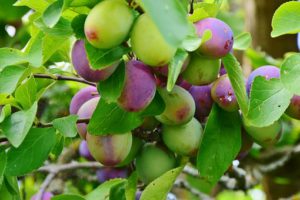
In order to produce a crop of decently sized plums by mid-May, you need to thin the fruit out. Firstly, you need to remove any diseased or damaged fruit. Secondly, you need to reduce overcrowding by thinning fruit to two fruits per growing station.
Plum tree branches get heavy and can snap unless it is either thinned of the branches are supported. Plums need to be pruned in summer to avoid silver leaf, which is also fatal to plum trees. Wasps love plums, and so to avoid your plums from being eaten, you will need to install wasp traps by the end of June. Plums can be self-fertile or they may require a partner in order to produce enough fruit.
There are four varieties of plum or plum-like trees: some varieties are better for eating, whilst others are better for cooking.
THERE ARE MANY DIFFERENT VARIETIES OF PLUM
- BULLACES: Definitely a cooking type, good for pies and tarts.
- DAMSONS: A plum-like fruit that is smaller than normal plums. They can be eaten raw but generally eaten cooked.
- GAGES: These are sweet green-yellow dessert plums that are often eaten raw.
- MIRABELLES or CHERRY PLUM: these are very hardy trees, worth considering if you can provide protection in winter. It is smaller than plum but just as sweet tasting.
- APRICOTS: Almost any apricot variety can be grown in containers. This orange plum-like fruit is a good choice for gardeners will limited space, as long as dwarf varieties are grown such as ‘Stark Golden Glo’ or ‘Stella’.

Apricot tree
‘Blue tit’ is one of the best variety of plum to grow in containers, as it is prolific, hardy and produces well-flavoured fruit. As with all fruit trees, minarettes varieties of plum exist.
One of the biggest problems with plums is that the fruit does not last long. They literally turn in a couple of days, so be prepared to make a lot of jams, tarts, pies or give away to your neighbours and friends.
THERE IS A TREE FOR YOU
In this article, the range of fruit trees that can be grown in containers have been discussed. It can be seen that a large number of fruit trees of different varieties can be grown in containers and that the minarette form are the best for those with limited space.
If you have been looking for a fruit tree to grow in a container you have plenty of choices, but remember there is a tree for you.
If you have any questions or comments, please feel free to leave me a comment below.
Happy fruit growing.

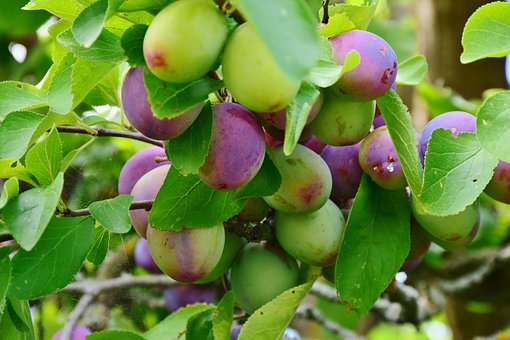
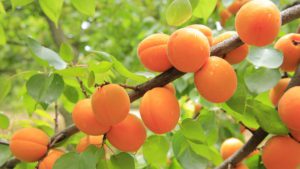
I just started learning how to plant flowers, and I thought I wanted to learn how to plant fruits using big pots, too! Since I don’t have a backyard or big space to plant trees, I am glad I came across this helpful article! I am excited to try and plant any fruit trees soon!
Hi Donna
if you had a choice to grow one tree in a container, then can I make the suggestion of growing cherries, as when ripe they are one of the most sweetest fruit you can grow and eat. Happy container gardening.
Thanks
Antonio
Hello there Antonio. Another much-appreciated post my friend. Growing your own fruit is already enough of a challenge by itself. Putting them in containers is quite helpful. If they are in pots, you can very easily move them around. Not so with ground planting. You also have the added advantage of preventing cross contamination such as with weeds or other harmful plants that could find your fruit. When I plant fruit trees in pots, I love to move the pots to the nearest honeybee hive inside a hollow tree. They love the sweet nectar from the flowers and my plants also get first class pollination to help them out on their journey.
Hi David
Thank you for those kind words, which are very much appreciated. If you treat your fruit trees right it will reward you with a large bounty of fresh fruit that will not only feed your family but everybody in your street where you live.
Kind regards
Antonio
Hey Antonio, I’m really glad I cam across your article. Firstly I appreciate your comments on simply taking seeds from fruits we eat from the supermarkets. I would not have differentiated them from seeds you buy separately. I live in the UK and have inherited a Greenhouse from the previous owner of my house. I will look into a fruit tree in there for sure. Thanks again
Thank you Bhavik
Growing fruit trees from seed are never viable, but you can buy ready made for quite a reasonable price. Who doesn’t love a fruit fresh from its tree? In a greenhouse, I would recommend growing tender fruit tree such as citrus if you can offer protection.
Antonio
Wow! Am so excited i came across this post. Never knew I could grow more than just flowers in a container but thanks to you I now know better. I always wanted to grow fruits in my backyard but lack of space made it almost impossible for me. Your advice is worth giving a try and I will surely try that of peer and citrus tree.
Thanks for sharing once again
Cheers!
Hi David
I am glad you found this article useful. Yes, you can grow fruit trees even if you have a small space to grow in. it is all about the right container size, right compost and the right type of fruit tree.
Kind regards
Antonio
Honestly, this article has intrigued me. The reason is, my father is a farmer, our family owns a farm with fruit bearing trees. I can’t imagine how it would be like if the trees grow into their maximum size, can the container handle the weight? What about the big roots, can they be contained in a container? Or, maybe can you suggest of a supplier for big containers that are suitable for this kind of project?
Hi Gomer
Moderrn fruit trees are dwarf compared to the old varieties used in orchards. As long as the container is large enough, the weight of the compost will support the tree, but it will be best to not place them where the wind seems to be the problem so that they will not get blown over.
The modern rootstock does not grow as large as they use to, as grafting has got around this problem. If the tree gets roots bound all you need to do is house the fruit tree in the next pot size up.
You will need a large container for fruit trees, around 60cm in diameter and height, as this will be sufficient.
Kind regards
Antonio
Hi, Antonio,
Great I should come across this webpage. My wife has been asking me to plant some fruit trees. And yes, she wants a cherry tree! I was going to ask what variety of cherry tree can I grow but then I see you’ve already answered that question.
I didn’t know that about growing fruit from seeds, from fruit nought at the supermarket. That was interesting!
My wife will be getting her cherry trees sooner than she expected. I intend to use to half-barrel pots, one in each corner of our patio.
Thank you for a very informative article!
Paul
Hi Paul
Thank you very much for those kind words. Cherry trees are a favorite of a lot of people and modern dwarf varieties are really suitable to be grown in container gardens, as long as you protect the fruit from the birds by using netting.
Kind regards
Antonio